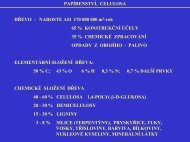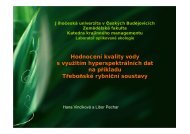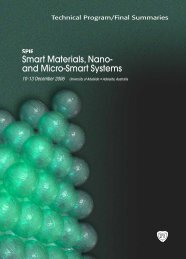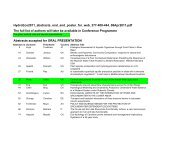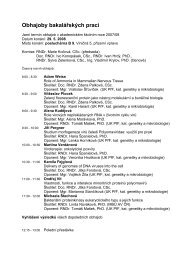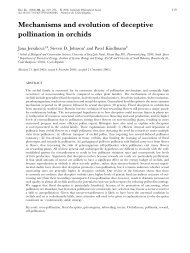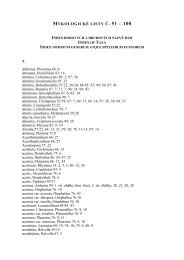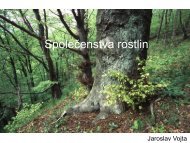View - CZECH MYCOLOGY
View - CZECH MYCOLOGY
View - CZECH MYCOLOGY
You also want an ePaper? Increase the reach of your titles
YUMPU automatically turns print PDFs into web optimized ePapers that Google loves.
Inhaltsverzeichnis1. Allgemeine Bedingungen2. Technische Parameter2.1. Videosignale2.1.1. Analoge Videosignale2.1.2. Digitale Videosignale2.2. Audiosignale2.2.1. Allgemeine Parameter2.2.2. Analoge Audiosignale2.2.3. Digitale Audiosignale3. Magnetbandaufzeichnung3.1. Sendeformate3.2. Aufzeichnungsparameter3.2.1. Time-Code3.2.2. Technischer Vorspann3.2.3. Programmaufzeichnung3.2.4. Fehlerrate3.2.5. MAZ-Karte3.2.6. Videocassetten4. Außenübertragung und Leitungsübertragung4.1 Außenübertragungen4.2 Überspielungen über Leitungen und Satelliten4.2.1 Bildüberspielungen4.2.2 Fernsehbegleitton-Überspielungen4.2.3 Digitale Überspielungen4.2.3.1 Digitale Überspielungen über landgebundene Verbindungen4.2.3.2 Digitale Überspielungen über Satellit4.3 Kommandoanbindung4.3.1 Kommando mittels Telefonhybrid4.3.2 Kommando mittels ISDN-Codec
KUBÁTOVÁ A.: CHAETOMIUM IN THE <strong>CZECH</strong> REPUBLIC AND NOTES TO THREE NEW RECORDSFinds of Chaetomium and Botryotrichum from soils in the former Czechoslovakiauntil 1988 were published by Řepová (1989a, 1989b) in her comprehensivelist of soil fungi in Czechoslovakia. She cited altogether six species of Chaetomiumfound in the area of the Czech Republic. Later records of Chaetomium andrecords from different substrates are dispersed over many other papers.The main aim of this study is to summarise published records of Chaetomiumspecies from the Czech Republic and present three species new to this area.MATERIALS AND METHODSThe species concept of Chaetomium is according to Arx et al. (1986). Theidentity of species previously published were not verified, due to absence of descriptionsor illustrations in most of the records.Five Chaetomium strains examined in this study were isolated during severalsurveys of micromycete diversity in the Czech Republic in 1993–2006. The surveyswere focused on:– fungi contaminating archive materials (1997): Neratovice, central Bohemia;isolation on soil extract agar with glucose and Bengal rose (SEA);– air-borne fungi (1995–97): outdoor air in Prague, air samples were aspirated byan impactor, isolation on wort-beer agar (WBA);– dried foods: Brno (as of 1999); isolation on yeast extract glucosechloramphenicol agar (YGC), see also Ostrý et al. (2002);– microfungi of biological soil crusts (since 2005): Ralsko, northern Bohemia;isolation on soil extract agar with glucose and Bengal rose (SEA).Isolated strains (see Tab. 1) were cultivated on malt extract agar (MEA: maltextract 20 g, peptone 1 g, glucose 20 g, agar 15 g, water 1000 ml), potato-carrotagar (PCA: potatoes 20 g, carrot 20 g, agar 15 g, water 1000 ml) and corn meal agar(CMA: cornmeal 60 g, agar 20 g, water 1000 ml) at 24–26 °C, 37 °C and 42 °C for 2–3weeks in the dark. Measurements of colonies on each medium were made onthree Petri dishes. Microscopic features were described from PCA after threeweeks.The Chaetomium strains were identified according to Arx et al. (1986). Photographswere taken on an Olympus BX-51 microscope using Nomarski contrast(DIC). Five living strains are maintained in the Culture Collection of Fungi (CCF),Dept. of Botany, Faculty of Science, Charles University, Prague, Czech Republic.Herbarium specimens (dried colonies) were deposited in the Herbarium of Dept.of Botany (PRC) at the same institute (see Tab. 1).157
<strong>CZECH</strong> MYCOL. 58(3–4): 155–171, 2006Tab. 1. Examined Chaetomium species.Species Strain no. Herbarium specimen no. Substrate, locality, date, isolated byC. aureum CCF 3252 PRC 295, PRC 296 fruit tea, Brno, Czech Republic, November2001, V. Ostrý as No. 282ACCF 3624 PRC 297 surface soil crust, near former airport Ralsko,N Bohemia, Czech Republic, January 2006, A.Kubátová as No. 27/06C. madrasense CCF 3412 PRC 298, PRC 299, PRC 300 out-door air, Prague, Czech Republic, December1996, A. Kubátová as No. 6/97CCF 3413 PRC 301, PRC 302, PRC 303 surface of book shelf in archive, Neratovice, NBohemia, Czech Republic, June 1997, A.Kubátová as No. 79/97C. robustum CCF 3260 PRC 304, PRC 305, PRC 306 out-door air, Prague, Czech Republic, February1996, A. Kubátová as No. 31/96RESULTS AND DISCUSSIONChaetomium species – list of published records from the Czech RepublicNotes:Records under each species are arranged chronologically.CCF = Culture Collection of Fungi, Prague.SMF ISB = Collection of Microscopic Fungi of the Institute of Soil Biology, České Budějovice.1More detailed data on locality not available.2Synonym according to Arx et al. (1986).3Nomen proposed by Arx et al. (1986) to be rejected; syn. of C. globosum according to CBS FilamentousFungi Database.4Nomen designed by Arx et al. (1986) as a possible older name of C. elatum.Botryotrichum piluliferum Sacc. et Marchal (anamorph) – see C. piluliferum (teleomorph)Chaetomium affine Corda – see C. elatum 2 (C. affine is a synonym of C. globosum according to CBSFilamentous Fungi Database 2006)Chaetomium aureum ChiversKubátová (this paper): CCF 3252, fruit tea, Brno, S Moravia;Kubátová (this paper): CCF 3624, surface soil crust, Ralsko, N Bohemia.Chaetomium bainieri Munk – see C. globosum 2Chaetomium bostrychodes ZopfBaudyš (1925) 1 ;Baudyš and Picbauer (1925): paper, Brno, S Moravia;Hubálek (1974a): feathers of Phasianus colchicus, Larus ridibundus, Passer domesticus,P. montanus, former Czechoslovakia 1 ;Hubálek (1974b): feather of four bird species, former Czechoslovakia 1 ;Hubálek et al. (1979) as C. microcephalum: hair of small mammals, former Czechoslovakia or formerYugoslavia 1 ;Urošević (1979) as C. bostrichoides: seeds of spruce and pine, Bohemia and Moravia.Chaetomium circinatum ChiversFassatiová (1966): soil of steppe, Doutnáč hill, Bohemian Karst, central Bohemia.158
KUBÁTOVÁ A.: CHAETOMIUM IN THE <strong>CZECH</strong> REPUBLIC AND NOTES TO THREE NEW RECORDSChaetomium madrasense NatarajanKubátová (this paper): CCF 3412, out-door air, Prague, and CCF 3413, archive materials,Neratovice, central Bohemia.Chaetomium microcephalum L. M. Ames – see C. bostrychodes 2Chaetomium murorum CordaCorda (1837): wall, Prague, central Bohemia;Svrček (1963): rotten wood in cavity of stem of Aesculus hippocastanum, soil under Liriodendrontulipifera, Prague, central Bohemia;Fassatiová (1966): forest steppe soil, Doutnáč hill, Bohemian Karst, central Bohemia;Hubálek et al. (1973): nests of Passer montanus, Parus ater, Ficedulla albicollis, Sitta europaea,Sturnus vulgaris, S Moravia 1 ;Hubálek (1974a): feathers and nests of several bird species, former Czechoslovakia 1 ;Hubálek (1974b): feathers of birds, former Czechoslovakia 1 ;Hubálek (1976a, 1976b): bird nests, S Moravia;Hubálek et al. (1979): hair of small mammals, former Czechoslovakia or former Yugoslavia 1 ;Kubátová (1987): phylloplane of Tilia cordata, Prague, central Bohemia;Bečvář (1998): substrate of spoil-banks, near Kladno, central Bohemia;Kubátová et al. (2003): CCF 2924, archive material, Prague, central Bohemia.Chaetomium olivaceum Cooke et Ellis – see C. globosum 2Chaetomium perlucidum SergeevaŘepová (1988): rhizosphere, former Czechoslovakia 1 .Chaetomium piluliferum J. DanielsFassatiová (1966) as Botryotrichum piluliferum: soil of steppe, Doutnáč hill, Bohemian Karst,central Bohemia;Smrž and Hrnčiřík (1981) as B. piluliferum: feed from plant substrata, former Czechoslovakia 1 ;Příhoda (1982): rotting plant matter of tobacco, Kostelec nad Č. L., central Bohemia;Fassatiová et al. (1987) as B. piluliferum: indoor air of archive, Prague, central Bohemia;Řepová (1988) as B. piluliferum: indoor air of archives, former Czechoslovakia 1 ;Řepová (1988) as B. piluliferum: soil, former Czechoslovakia 1 ;Hýsek (1993) as B. piluliferum: forest soils, Strouha and Vojířov near Temelín, S Bohemia;Kubátová and Prášil (1995) as B. piluliferum: wall of flat, Ústí nad Labem, N Bohemia;Nováková (1996) as B. piluliferum: CMF ISB 218, apple orchard soil, Bavorov, S Bohemia;Nováková (1996) as B. piluliferum: CMF ISB 445, CMF ISB 537, CMF ISB 561, soil, Chelčice, S Bohemia;Pazdziora (2000) as B. piluliferum: dwelling, Jičín district, NE Bohemia;Nováková (2001) as B. piluliferum: forest soil, Šumava Mts., S Bohemia;Kubátová et al. (2003) as B. piluliferum: CCF 1155, wellington boots, Vizovice, E Moravia;Nováková and Pižl (2003) as B. piluliferum: vermiculture substrate, Frýdek-Místek, NE Moravia.Chaetomium reflexum Skolko et J. W. GrovesHubálek (1974a): feathers of Anser anser, Passer domesticus, former Czechoslovakia 1 ;Hubálek (1974b): feathers and nests of several birds, former Czechoslovakia 1 ;Kubátová (1987): phylloplane of Ulmus carpinifolia, Prague, central Bohemia.Chaetomium robustum L. M. AmesKubátová (this paper): CCF 3260, out-door air, Prague, central Bohemia.Chaetomium spinosum ChiversNováková and Pižl (2003): vermiculture substrate, Mikulčice, Frýdek-Místek, NE Moravia.Chaetomium spirale Zopf 3 – see C. globosumChaetomium spirochaete PalliserSvrček (1963): soil under Juglans cinerea, Prague, central Bohemia.161
<strong>CZECH</strong> MYCOL. 58(3–4): 155–171, 2006Excluded recordsChaetomium fiscicola Petr. – current name Zopfiella leucotricha (Speg.) Malloch et Cain (accordingto Arx et al. 1986 and CBS Filamentous Fungi Database 2006)Petrak (1915) as C. fiscicolum: rotten twigs of Salix sp., E Moravia.Chaetomium merdarium – unknown name, probably a mistakeKonečný and Smrž (1979): storage space for eggs, former Czechoslovakia 1 .In the above list, 17 currently accepted Chaetomium species known from theCzech Republic are given. They were isolated or found on many different substrates:excrements, bird feathers and nests, hair, soil, rhizosphere, roots, leaves,phylloplane, stems of herbs, straw, wood, seeds, tea, feed, paper, archive materials,clinical material, and air. Twenty-five strains of nine Chaetomium species areat present maintained in culture collections in the Czech Republic (see accessionnumbers in the list above).The first published finds of Chaetomium from our area are probablyC. elatum, C. globosum and C. murorum by Corda (1837). The most often recordedspecies are C. globosum (mentioned in 26 papers), C. elatum (18),C. indicum (15), C. murorum (12), C. piluliferum (12), and C. funicola (9). Theauthor aimed to complete a list of Chaetomium records in the Czech Republic;nevertheless it is possible that some papers were neglected, thus the species listshould be considered as preliminary.Regarding this species-rich genus, the 17 species known from the Czech Republicis a somewhat low number. However, the numbers of Chaetomium speciesrecorded in other countries are neither very high, whether dealing both small orlarge countries, or different substrates. For example, Lodha (1964) reported 12species from dung in India. Novák (1966) recorded 15 Chaetomium species fromsoil and herbal material in Hungary. Robledo and Cifuentes (1986) recorded 16Chaetomium species in Mexico. Smickaya et al. (1986) listed 18 species for thearea of Ukraine. Cherepanova (1989b) reported 45 species from the large area ofthe former Soviet Union. Soytong (1990) reported 15 species of Chaetomiumfrom soils in Thailand. Lorenzo (1993) cited 13 species from Argentina. Lizoň andBacigálová (1998) mentioned ten species from various substrates in Slovakia. Bell(2005) reported 16 coprophilous species of Chaetomium from Australia.Although Chaetomium did not belong to neglected genera, comprehensivedata on occurrence and distribution of some known as well as newly describedChaetomium species in individual countries are somewhat poor. Many data ontheir occurrence are also hidden in herbaria. Thus it seems that a new monographictreatment of this striking genus would be very appreciated.162
KUBÁTOVÁ A.: CHAETOMIUM IN THE <strong>CZECH</strong> REPUBLIC AND NOTES TO THREE NEW RECORDSNotes to three Chaetomium species isolated in the Czech Republic for thefirst timeChaetomium aureum Chivers 1912 Figs. 1 and 2Syn. Chaetomium trilaterale Chivers 1912C. trilaterale var. diporum J. C. Cooke 1973and others (according to Arx et al. 1986)Morphological characteristics of the studied strains (CCF3252, CCF 3624)C o l o n i e s on PCA after two weeks grey to grey-green due to formation ofascomata, the reverse is grey-violet, agar vinaceous. Colonies on CMA similar, differingonly in rather weak sporulation and more intensive pigments. Colonies onMEA have an ochraceous mycelium; orange to vinaceous red pigments are producedinto agar; the reverse is dark vinaceous; ascomata are not formed. Growthof colonies is better on CMA (see Tab. 2), sporulation is better on PCA, formationof pigments is most pronounced on MEA and CMA (Fig. 2a–b). Growth at 37 °C isbetter than at 24–26 °C (Tab. 2), however no sporulation was observed at 37 °C after14 days. No growth was observed at 42 °C.A s c o m a t a (Fig. 1a) globose, c. 140 μm diam. A s c o m a t a l h a i r s dark pigmented,septate, verrucose, arcuate, apically coiled, 4–6 μm wide near the base,up to 2 μm near the tip. A s c i (Fig. 1b) clavate, 8-spored, about 35 × 11 μm. A s c o -s p o r e s brown, in strain CCF 3252 (Fig. 1c) navicular, with germ pores at bothends, 8–9.5 × 5–6 μm, in strain CCF 3624 (Fig. 2c) inaequilaterally fusiform, withsingle germ pore, 9–12 × 5 μm.Observations of microscopic and macroscopic features are in accordance withthe broad concept of C. aureum by Arx et al. (1986). Strain CCF 3252 with itsbiporate ascospores fits to C. trilaterale var. diporum (= syn. of C. aureum). Itsnavicular to reniform ascospores also resemble the close species C. cupreumAmes. This species however differs by copper coloured hairs. Both isolatedstrains differ also slightly in colony diameters. It is not sure, if it is an isolate-typicalfeature or if the quality of the inoculum used (unequal size or different age)plays a role here.D i s t i n g u i s h i n g f e a t u r e s . Production of vinaceous red pigments, arcuateand apically coiled hairs, inaequilaterally fusiform or navicular ascospores,good growth at 37 °C.N o t e s o n h a b i t a t a n d d i s t r i b u t i o n . The species is known from manycoutries and from various substrates. It was reported from seeds of Capsicumannuum and Cucumis sativus in USA (Skolko and Groves 1953), from Avenasativa in Canada (Conners 1967), from Fragaria sp. in Canada (Ginns 1986).Bernát et al. (1984) isolated Chaetomium trilaterale from agricultural soils in163
<strong>CZECH</strong> MYCOL. 58(3–4): 155–171, 2006Slovakia. Several records are mentioned in Arx et al. (1986) and in CBS FilamentousFungi Database (2006): from tobacco, from Arachis hypogaea (USA), fromsoil (USA, Ecuador, Ivory Coast, South Africa), dung (Canada, East Africa), compost(Brazil). Soytong (1990) recorded this species from soils in Thailand.Zhdanova et al. (1995, 2001) considered this species a bioindicator of soils pollutedwith radionuclides near Chernobyl, Ukraine. They reported this species alsofrom radioactive forest litter near Chernobyl (Zhdanova et al. 2005). Chaetomiumaureum was also isolated from hypersaline water of the Dead Sea (Molitoris et al.2000), from pineapple field soil and snap bean seed in Japan (Watanabe 2002), andit was reported to be associated with mangrove in Japan (Schmit and Shearer2003). Zang et al. (2004) found this species associated with roots of Cypripediumflavum in China together with Papulaspora byssina.Chaetomium madrasense Natarajan 1971 Fig. 3Morphological characteristics of the studied strains (CCF3412, 3413)C o l o n i e s on PCA and CMA after two weeks dark grey due to formation ofascomata. No pigments produced into the agar medium. Colonies on MEA olive green.Sporulation is good on all three media. Growth of colonies is better on CMA. Growth at37 °C is variable: 6–22 mm after 7 days on PCA (Tab. 2). At 42 °C no growth.A s c o m a t a (Fig. 3a) subglobose, c. 250–315 × 160–220 μm. A s c o m a t a lh a i r s on PCA whitish, on MEA yellowish in reflected light, undulate or coiled,septate, finely verrucose, c. 2.5–3 μm thick. A s c i (Fig. 3b) clavate, 8-spored, c. 60× 18 μm. A s c o s p o r e s (Fig. 3c) brown, smooth, broadly limoniform tosubglobose in face view, slightly biapiculate, usually with a bulge (in lateral view),with an apical pore, 8–10 × 7 μm. Ascospores are pushed out of the ascoma in distortedbands.Most of morphological features agree with those given by Arx et al. (1986),only the size of ascospores of our strain fit to the lower dimensions mentioned byArx et al. and the ascomatal hairs of our strains are somewhat pale.D i s t i n g u i s h i n g f e a t u r e s . It is similar to C. globosum and C. sphaerale,however differs by ascospores which have a distinct bulge at one side. C. citrinumhas similar ascospores of irregular shape, however its ascomatal hairs arehyphae-like.Notes on habitat and distribution. C. madrasense is considered to bea rather common species (Arx et al. 1986). It is known from several types of substratefrom various regions of the world: e.g. from the rhizosphere of Pennisetumtyphoides and a leaf of Triticum aestivum (India), from seed of Linumusitatissimum and dung of goat (Israel), from soil (Kenya), from dung (France), andfrom Gossypium humitectum (Argentina) (CBS Filamentous Fungi Database 2006).164
KUBÁTOVÁ A.: CHAETOMIUM IN THE <strong>CZECH</strong> REPUBLIC AND NOTES TO THREE NEW RECORDS1a 1b 1cFig. 1. Chaetomium aureum CCF 3252.1a – ascoma, bar = 100 μm;1b – ascus with immature ascospores, bar = 10 μm;1c – ascospores, bar = 10 μm.2a 2b 2cFig. 2. Chaetomium aureum CCF 3624.2a – colony on MEA, 8 days, 25 °C, bar = 10 mm;2b – colony on CMA, 8 days, 25 °C, bar = 10 mm;2c – ascospores, bar = 10 μm.Photo A. Kubátová165
<strong>CZECH</strong> MYCOL. 58(3–4): 155–171, 20063a 3b 3cFig. 3. Chaetomium madrasense CCF 3412.3a – ascoma, bar = 100 μm;3b – asci with immature ascospores, bar = 20 μm;3c – ascospores, bar = 10 μm.4a 4b 4cFig. 4. Chaetomium robustum CCF 32604a – ascoma, bar = 100 μm;4b – ascomatal wall cells near the ostiolum, bar = 50 μm;4c – ascospores, bar = 10 μm.Photo A. Kubátová166
KUBÁTOVÁ A.: CHAETOMIUM IN THE <strong>CZECH</strong> REPUBLIC AND NOTES TO THREE NEW RECORDSChaetomium robustum L. M. Ames 1963 Fig. 4Morphological characteristics of the studied strain (CCF 3260)C o l o n i e s on PCA have no aerial mycelium after two weeks; centre of coloniesdark grey due to forming of ascomata, the reverse pale. Colonies on CMAsimilar, differing only in the formation of scarce mycelium, pale yellow pigmentsin agar and yellow-grey reverse. Colonies on MEA grow poorly, are yeast-like, withyellowish centre; ascomata not formed. Growth of colonies and sporulation betteron PCA and CMA (see Tab. 2). No growth at 37 °C and 42 °C.A s c o m a t a (Fig. 4a) elongated, ampulliform, c. 300–500 × 180–310 μm.A s c o m a t a l w a l l c e l l s (Fig. 4b) near the ostiolum elongated and arranged inpallisade-like rows. A s c o m a t a l h a i r s on CMA grey in reflected light, poorlybranched, septate, verrucose, spirally coiled, 5–7.5 μm thick at lower part, tapered;lateral hairs seta-like, not coiled. A s c i clavate, 8-spored, c. 35–37 × 10–11 μm.A s c o s p o r e s (Fig. 4c) brown pigmented, broadly limoniform, with an apicalgerm pore, 6 × 5.5 μm.This observation is in accordance with Arx et al. (1986).D i s t i n g u i s h i n g f e a t u r e s . Two types of hairs (coiled and tapered),pallisade-like rows of elongated cells near the ostiolum, broadly limoniform ascosporeswith one germ pore.N o t e s o n h a b i t a t a n d d i s t r i b u t i o n . Only scarce information existson C. robustum finds. Arx et al. (1986) and CBS Filamentous Fungi Database(2006) mentioned strains isolated from soil in USA, Mexico, Jamaica and Israeland from litter in Jamaica. Bell (2005) recorded this species on dung in Australia.Tab. 2. Colony diameters (mm) of three examined Chaetomium species on PCA, CMA and MEA at24–26 °C, 37 °C and 42 °C.IncubationtemperatureMedium, daysC. aureumCCF 3252C. aureumCCF 3624C. madrasenseCCF 3412C. madrasenseCCF 3413C. robustumCCF 326024–26 °C PCA 7 22–29 28–33 41–57 46–60 32–38PCA 10 36–43 43–45 68–whole dish 78–whole dish 48–56PCA 14 52–56 61–63 78–whole dish 82–whole dish 75–85CMA 7 25–35 28–30 48–66 57–67 31–35CMA 10 42–50 44–45 68–whole dish whole dish 46–51CMA 14 59–65 66 whole dish whole dish 67–75MEA 7 24–30 30–32 32–42 31–40 11–14MEA 10 33–38 47 58–70 58–whole dish 13–14MEA 14 40–52 66–67 whole dish whole dish 15–1737 °C PCA 7 28–38 40–45 6–13 9–22 no growthPCA 10 48–54 55–60 10–25 15–36 no growthPCA 14 53–67 64–65 23–39 25–50 no growth42 °C PCA 7 no growth no growth no growth no growth no growth167
<strong>CZECH</strong> MYCOL. 58(3–4): 155–171, 2006ACKNOWLEDGEMENTSThe author is indebted to Dr. V. Ostrý (National Institute of Public Health,Brno) for providing a Chaetomium strain from food.This study was supported by an institutional project of the Ministry of Education,Youth and Sports of the Czech Republic (MSM 0021620828) and partly alsoby a grant of the Ministry of Environment of the Czech Republic (SM/2/90/05) andMinistry of Agriculture of the Czech Republic (13/2006-2199St).REFERENCESABDULLAH S. K. and ZORA S. E. (1993): Chaetomium mesopotamicum, a new thermophilic speciesfrom Iraqi soil. – Crypt. Bot. 3: 387–389.AMES L. M. (1963): A monograph of the Chaetomiaceae. – 125 p. Washington.ARX J. A. von, DREYFUSS M. and MÜLLER E. (1984): A revaluation of Chaetomium and theChaetomiaceae. – Persoonia 12(2): 169–179.ARX J. A. VON,GUARRO J. and FIGUERAS M. J. (1986): The ascomycete genus Chaetomium. – Beih. NovaHedwigia 84: 1–162.BAINIER G. (1910): Monographie des Chaetomidium et des Chaetomium. – Bull. Soc. Mycol. Fr. 25:191–237.BAUDYŠ E. (1925): Příspěvek k rozšíření mikromycetů u nás [La seconde contribution pourélargissement des micromycetes dans la Bohême (en Tchèque)]. – Čas. Morav. Mus. Zem. 22–23:1–31 [in Czech].BAUDYŠ E. and PICBAUER R. (1925): Příspěvek ke květeně hub Československé republiky I. [Addendaad floram Čechoslovakiae mycologicam I.]. – Sborn. Klubu Přírod. Brno 7: 44–68 [in Czech].BEČVÁŘ K. (1998): Occurrence and diversity of microfungi and their communities in substrata of spoilbanks. – Novit. Bot. Univ. Carol. 12/1998: 53–71.BELL A. (2005): An illustrated guide to the coprophilous Ascomycetes of Australia. – 172 p. Utrecht.BERNÁT J., DUBOVSKÁ A. and BRAUNOVÁ O. (1984): Micromycetes in agricultural soils of Slovakia. –Acta Fac. Rer. Natur. Univ. Comen. – Microbiol. 13: 3–21.CBS Anamorph–Teleomorph Database (2006): http://www.cbs.knaw.nl/CBS Filamentous Fungi Database (2006): http://www.cbs.knaw.nl/CHEREPANOVA N. P. (1989a): Sistěma roda Chaetomium Kze.: Fr. – Novosti Sist. Niz. Rast. 26: 91–93.CHEREPANOVA N. P. (1989b): Sumčatyje griby roda Chaetomium. – 165 p. Leningrad [in Russian].CONNERS I. L. (1967): An annotated index of plant diseases in Canada and fungi recorded on plants inAlaska, Canada and Greenland. – Res. Br. Can. Dept. Agr. Publ. 1251: 1–381.CORDA A. C. J. (1837): Icones fungorum hucusque cognitorum. Vol. 1. – 32 p., 7 tabs. Prague.CORDA A. C. J. (1840): Icones fungorum hucusque cognitorum. Vol. 4. – 53 p., 10 tabs. Prague.ČÍŽKOVÁ D. (1983): Mykoflora semen a šišek smrku ztepilého (Picea excelsa Link) a borovice lesní(Pinus silvestris L.) [The mycoflora of seeds and cones of Norway spruce (Picea excelsa Link) andScotch pine (Pinus silvestris L.)]. – Sborn. Úst. Apl. Ekol. Ekotech. VŠZ Praha 1: 49–65 [in Czech].DECOCK C. and HENNEBERT G. L. (1997): A new species of Chaetomium from Ecuador. – Mycol. Res.101: 309–310.FASSATIOVÁ O. (1966): Bodenmikromyceten am Hügel Doutnáč im Böhmischen Karst. – Preslia 38:1–14.FASSATIOVÁ O. (1995): Micromycetes in archives and book depositories in the Czech Republic. – CzechMycol. 48(1): 77–86.168
<strong>CZECH</strong> MYCOL. 58(3–4): 155–171, 2006LORENZO L. E. (1993): Especies coprofilas de la familia Chaetomiaceae en la Patagonia (Argentina). –Bol. Soc. Argent. Bot. 29(3–4): 159–172.MAZZUCCHETTI G. (1965): Microfunghi della cellulosa e della carta attivita’ e inquadramentosistematico. Il genere Chaetomium. – 364 p. Roma.MOLITORIS H. P., BUCHALO A. S., KURCHENKO I., NEVO E., RAWAL B. S., WASSER S. P. and OREN A. (2000):Physiological diversity of the first filamentous fungi isolated from the hypersaline Dead Sea. –Fung. Div. 5: 55–70.NOVÁK E. T. (1966): Chaetomium–Arten aus Ungarn. – Ann. Univ. Sci. Budapest, Rolando Eötvös nom.,Sect. Biol. 8: 201–222.NOVÁKOVÁ A. (1996): Collection of microscopic fungi ISB. Catalogue of strains. – 32 p. ČeskéBudějovice.NOVÁKOVÁ A. (2001): Soil saprotrophic micromycetes in Norway spruce forests in the Šumava NationalPark. – Silva Gabreta 7: 177–184.NOVÁKOVÁ A. and BLAŽKOVÁ P. (2000): Mikroskopické houby v půdách vybraných horských smrčinČeské republiky [Microscopic fungi in soils of selected mountain spruce forests in the Czech Republic].– Silva Gabreta 5: 63–68 [in Czech].NOVÁKOVÁ A. and PIŽL V. (2002): Mykoflóra vermikompostů a střevního traktu Eisenia andrei[Mycoflora of vermicultures and intestines of Eisenia andrei]. – In: Život v pôde [Life in soil], 3.medzinárodný seminár [3rd Int. Conf.], p. 116–122, Bratislava [in Czech].NOVÁKOVÁ A. and PIŽL V. (2003): Mycoflora of the intestine of Eisenia andrei (Oligochaeta,Lumbricidae) and in vermiculture substrata. – Czech Mycol. 55(1–2): 83–102.NOVOTNÝ D. (1999): Srovnání dvou metod použitých při studiu mikroskopických hub kořenů dubů. – In:Jankovský L., Krejčíř R. and Antonín V. [eds.], Houby a les, Sborník referátů, p. 161–164, Brno [in Czech].NOVOTNÝ D. (2003): A comparison of two methods for the study of microscopic fungi associated withoak roots. – Czech Mycol. 55(1–2): 73–82.OPIZ F. M. (1852): Seznam rostlin květeny české. – 216 p. Praha [in Czech].OSTRÝ V., RUPRICH J., ŠKARKOVÁ J., PROCHÁZKOVÁ I. and KUBÁTOVÁ A. (2002): MYKOMON – monitoringproject of toxigenic fungi in food in years 1999–2001. – Mycotox. Res. 18A(2): 193–197.PAZDZIORA E. (2000): Mikroskopické vláknité houby v bytech. – In: Davidová P. and Rupeš P. [eds.],Sborník referátů IV. konference DDD 2000, p. 125–137, Poděbrady.PETRAK F. (1915): Beiträge zur Pilzflora von Mähren und Österr.–Schlesien. – Ann. Mycol. 13: 44–51.PICBAUER R. (1927): Addenda ad floram Čechoslovakiae mycologicam III. – Sborník Vys. Šk. Zeměd.Brno, Fak. Lesn. 1927/D7: 3–25.PICBAUER R. (1929): Addenda ad floram Čechoslovakiae mycologicam IV. – Sborn. Vys. Šk. Zeměd.Brno, Fak. Lesn. 1929/D13: 1–28.PICBAUER R. (1931): Addenda ad floram Čechoslovakiae mycologicam V. – Sborn. Vys. Šk. Zeměd.Brno, Fak. Lesn. 1931/D18: 1–30.PICBAUER R. (1938): Addenda ad floram Čechoslovakiae mycologicam. Pars VIII. – Verh. Naturforsch.Ver. Brünn 69: 29–45.PICBAUER R. (1941): Beitrag zur Pilzflora von Böhmen, Mähren und der Slowakei. – Verh. Naturforsch.Ver. Brünn 73: 177–203.PILÁT A. (1938): Seznam druhů hub, popsaných A. C. J. Cordou s udáním originálních exemplářů, kteréjsou uloženy v herbáři Národního muzea v Praze [Liste der von A. C. J. Corda beschriebenenPilzarten, mit Angabe der Originalexemplare, die im Herbarium des Nationalmuseums in Pragaufbewahrt sind]. – Sborn. Nár. Muz. Praha 1B(10): 139–170.PŘÍHODA A. (1982): Houby rostoucí na tabákové drti [The fungi rotting plant matter of tobacco]. – Čes.Mykol. 36(1): 40–44 [in Czech].ROBLEDO M. and CIFUENTES J. (1986): Nuevos registros del genero Chaetomium (Chaetomiaceae) enMexico. – Rev. Mex. Mic. 2: 279–295.RODRIGUEZ K., STCHIGEL A. and GUARRO J. (2002): Three new species of Chaetomium from soil. –Mycologia 94: 116–126.170
KUBÁTOVÁ A.: CHAETOMIUM IN THE <strong>CZECH</strong> REPUBLIC AND NOTES TO THREE NEW RECORDSŘEPOVÁ A. (1986): Výskyt mikroskopických hub v ovzduší budovy ČSAV v Českých Budějovicích [Occurrenceof microscopic fungi in air of the building of the Czechoslovak Academy of Sciences inČeské Budějovice]. – Čes. Mykol. 40: 19–29 [in Czech].ŘEPOVÁ A. [ed.] (1988): Materiály k seznamu mikroskopických hub izolovaných v ČSSR v roce 1986. –Mykol. Listy 33: 8–13 [in Czech].ŘEPOVÁ A. (1989a): Soil micromycetes from Czechoslovakia – a list of isolated species with bibliography.II. – Čes. Mykol. 43: 169–175.ŘEPOVÁ A. (1989b): Soil micromycetes from Czechoslovakia – a list of isolated species with bibliography.II. – Čes. Mykol. 43: 235–243.ŘEZÁČOVÁ V. and KUBÁTOVÁ A. (2005): Saprobic microfungi in tea based on Camellia sinensis and onother dried herbs. – Czech Mycol. 57(1–2): 79–89.SETH H. K. (1970): A monograph of the genus Chaetomium. – Beih. Nova Hedwigia 37: 1–133 p., 117figs.SCHMIT J. P. and SHEARER C. A. (2003): A checklist of mangrove–associated fungi, their geographicaldistribution and known host plants. – Mycotaxon 80: 423–477.SKOLKO A. J. and GROVES J. W. (1953): Notes on seed–borne fungi VII. Chaetomium. – Can. J. Bot. 31:779–809.SMICKAYA M. F., SMYK L. V. and MEREZHKO T. A. (1986): Opreděliteľ pirenomycetov USSR. – 363 p. Kiev[in Russian].SMRŽ P. and HRNČIŘÍK K. (1981): Termofilní mykoflóra ve velkochovech skotu. – Veterinářství 31(7):299–300 [in Czech].SOYTONG K. (1990): A taxonomic study of Chaetomium spp. in Thailand. – In: Reisinger A. andBresinsky A. [eds.], 4th International Mycological Congress Abstracts, p. 55, Regensburg.SVRČEK M. (1963): Askomycety izolované z půdy a dřeva metodou Krzemieniewských [Ascomycetesisolated from soil and wood by the method of H. and S. Krzemieniewski]. – Čes. Mykol. 17(3):134–140 [in Czech].THÜMEN F. VON (1875): Beiträge zur Pilz–Flora Böhmens. – Verhandl. Zool.–Bot. Ges. Wien 25: 523–554.TOMŠÍKOVÁ A. and NOVÁČKOVÁ D. (1970): Zum Studium der opportunistischen Pilze. I. Pilzflora in derAtmosphäre von Pilsen (ČSSR) (Teil A). – Mykosen 13(12): 589–602.UDAGAWA S. (1960): A taxonomic study on the Japanese species of Chaetomium. – J. Gen. Appl.Microbiol. 6: 223–251.UDAGAWA S.–I., UCHIYAMA S. and KAMIYA S. (1994): Two new species of pyrenomycetous Ascomycetesfrom New Caledonia. – Mycoscience 35: 319–325.UROŠEVIĆ B. (1961): Mykoflora žaludů v období dozrávání, sběru a skladování [Fungi of acorns in theperiod of ripening, collection and storage]. – Pr. Výzk. Úst. Lesn. ČSSR 21: 81–203 [in Czech].UROŠEVIĆ B. (1979): K otázce patogenity mykoflóry semen jehličnanů [On the problem of the pathogenicityof the mycoflora in conifer seeds]. – Lesnictví 25(4): 325–338 [in Czech].WATANABE T. (2002): Pictorial atlas of soil and seed fungi. 2nd ed. – 486 p. Boca Raton etc.ZANG M., WANG R. L. and HU H. (2004): Bulbils exist in root of Cypripedium flavum. – Acta Bot.Yunnan. 26(5): 495–496.ZOPF W. (1881): Zur Entwicklungsgeschichte der Ascomyceten: Chaetomium. – Nova Acta K.Leop.–Carol. Akad. Nat. 42(5): 199–292. [cit. sec. Arx et al. 1986]ZHDANOVA N. N., KUCHMA N. D., VASILEVSKAYA A. I., ZAKHARCHENKO V. A., NAKONECHNAYA L. T. andARTYSHKOVA L. V. (2005): Mycobiota of forest litter of Chernobyl limit zone and its influence on137Cs accumulation by pine seedlings (Pinus silvestris). – Mikol. Fitopatol. 39(1): 18–26.ZHDANOVA N. N., ZAKHARCHENKO V. A., ARTYSHKOVA L. V., SCHKOLNY A. T. and VASILEVSKAYA A. I. (2001):Mycobiota of radionuclides polluted soils of limits zone of ChNPP in 14 years after accident. –Mikol. Fitopatol. 35(6): 1–8.ZHDANOVA N. N., ZAKHARCHENKO V. A., VASILEVSKAYA A. I., PUSHKAREV A. V., NAKONECHNAYA L. T. andARTYSHKOVA L. V. (1995): New approach to the revelation of micromycetes – bioindicators of soilpollution in ukrainian woodlands. – Mikol. Fitopatol. 29(1): 23–29 [in Russian].171


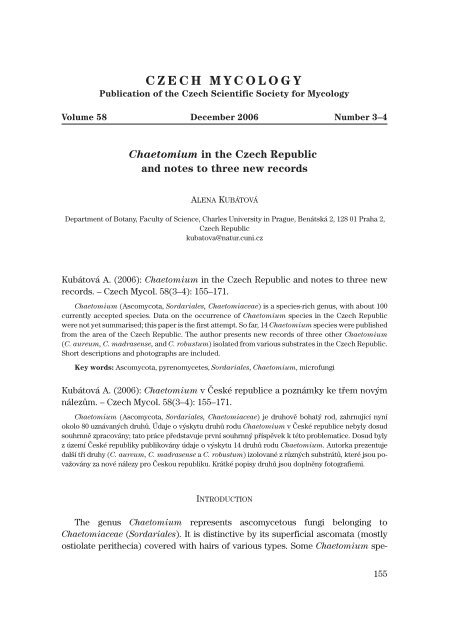
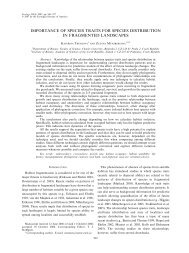
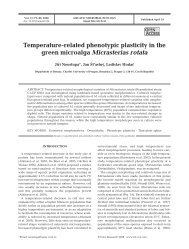
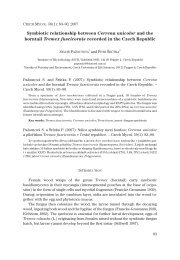
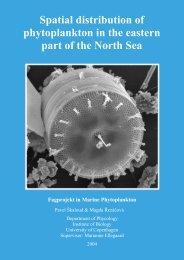
![[Cr(urea)6]Cl3](https://img.yumpu.com/47220263/1/184x260/crurea6cl3.jpg?quality=85)
